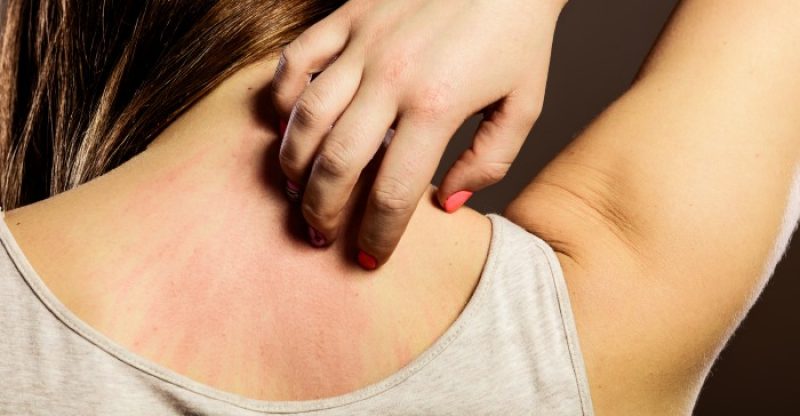21 Proven Home Remedies for Stubborn Rashes
Rashes affect millions of people globally.
Some rashes may need no treatment and will clear up on their own, and some can be treated at home, while others might be a sign of something more serious and will require emergency medical attention.
Most of us have had to deal with rashes at some point.
Unfortunately, they tend to appear when we least expect them.
It is worse when they are itchy and appear in awkward places such as the armpits; you can neither itch in public, nor can you ignore the itch.
What a dilemma!
So, let’s take a look at how to get rid of a rash!
We are going to give you a comprehensive list of twenty home rash remedies that will equip you to handle any kind of rash whenever it occurs.
Considering how randomly rashes develop, most times it is hard to point out what could have triggered it.
Rashes come in many forms and shapes.
Some rashes are pretty basic, such as a poison ivy rash, while others are very difficult to manage.
Several factors may cause you to have a rash.
Allergies, coming into contact with chemicals, food irritants, medication, indigestion, and illness are a few examples.
The incubation period for rashes also varies from one type to another.
Some rashes will appear out of nowhere, while others will prime you with subtle symptoms before the rash finally appears on your skin.
This latter type may take longer to disappear.
If you or your child is stranded at home with a stubborn rash, I have come to your rescue.
These tips will clear the rash in no time, leaving your skin clear as a babe’s.
What is a Rash?
A rash in medical terms is dermatitis, which can be broken down into “derma,” or skin, and “itis,” or inflammation.
Dermatitis it thus inflammation of the skin.
And contact allergic dermatitis is an itchy rash (1).
Rashes are differentiated based on several factors, such as what caused them or how they have presented.
Some symptoms are common to most kinds of rashes and will make you aware that this is a rash (2).
These symptoms include:
- Redness on the affected part of the skin
- Elevations/bumps on skin
- The skin becomes itchy
- Red patches or blotches on skin
- Ring-shaped marks on skin
- Warmth on the skin
- Appearance of blisters
- Patches of skin could be flaky
- When you itch the sores, they may ooze and later form a crust
- The rash may form pus
All these symptoms can be dealt with easily at home with natural home rash remedies.
This will save you a trip to the doctor’s office.
Before we go into the remedies, it is vital to understand the different types of rashes, because remedies will vary from one type of rash to another.
A rash is actually not a disease or condition on its own.
The term dermatitis just describes the reaction taking place on your skin in accordance with the symptoms you are having.
Sometimes, there is a medical pathology occurring that is causing the rash to appear.
Other times, it could be something irritating the surface of your skin that could make you itch and develop a rash, e.g. coming into contact with an allergen such as wool.
Some common types of rashes include:
- Atopic dermatitis
- Christmas tree rash (pityriasis rosea)
- Contact dermatitis
- Sun rash
- Heat rash
- Seborrheic dermatitis (dandruff)
- Poison ivy rash
- Drug rash
- Heat rash
- Intertrigo
- Lichen planus
- Psoriasis
- Hives
- Rosacea
- Stress rash
- Measles Rash
- Chickenpox rash
- Tinea corporis (ringworm of the body)
- Herpes zoster (shingles)
- Cercarial dermatitis (swimmer’s itch)
This list goes on.
A rash is usually a symptom of some changes taking place in the body.
This is what causes the difference in how rashes will develop and present.
The type of rash will point you to its cause, and vice versa.
For instance, chickenpox rash appears due to exposure to the chicken pox virus.
Other factors that may trigger rashes include:
- Food and other allergies
- Medication side effects
- Anxiety
- Poison ivy
- Parasitic infections, e.g. scabies
- Skin contact with irritants, such as detergents
- Fungal infections, e.g. ringworm
- Eczema and acne
- Bacterial infections, such as secondary syphilis, which causes shingles
- Autoimmune disorders such as psoriasis
- Constant scratching of the skin
- Poor hygiene
- Pregnancy
- Lyme disease
- Lupus
- Bites, such as bug bites and bee stings
- Too much exposure to heat, as in heat rash
- Too much exposure to moisture, as in a diaper rash
Most kinds of infections, be they bacterial, parasitic, or viral, may trigger a rash to develop.
Also, a positive history of allergic reactions such as asthma will increase your likelihood to develop rashes.
Another group of people very likely to develop rashes are outdoorsy people.
Being outdoors most of the time will expose you to risk factors such as bugs, poison ivy, poison oak, etc.
Medical Treatment for Rashes
People approach rashes differently, as some will rush to the hospital to seek treatment, others will self-prescribe skin ointments, and others will just endure the rash and wait it out.
If you go to a hospital or clinic, chances are you will be given a topical ointment that has analgesic (pain relieving) and anti-inflammatory components.
Most ointments will contain cortisone as the anti-inflammatory component.
As much as cortisone will provide the anti-inflammatory effect desired, long-term use will cause your skin to thin (3) which eventually may lead you to develop more rashes.
The side effects are both on the skin (cutaneous) and within your body (systemic).
With this in-depth background on rashes, we can delve into the home remedies one by one.
Your search for “home remedies to get rid of rash” will come to an end when you’ve read this article.
Natural Treatments for Rash
Top Foods to Clear Rash
Organic Foods
Choose organic foods if you want to keep rashes at bay.
You need to steer clear of the dirty dozen list of foods that are pesticide-ridden.
Organic foods can be more expensive initially, but in the long run, you will save yourself more money that you would have used in medical expenses.
Find the nearest organic markets near you, and also be proactive in reading the labels of fruits and veggies to ascertain that the source is organic and no chemicals and pesticides were used to grow them.
Carotenoids
Carotene is the substance that gives some foods their characteristic bright orange or bright yellow color.
Pumpkin, for example, is a food that is rich in carotene.
Other than clearing rashes, the pumpkin will give your skin a glow.
Other foods rich in carotene include carrots, sweet potatoes, spinach, and fruits like apricots and cantaloupe.
These foods help to build an immunity against rashes triggered by exposure to the sun.
Sufficient Clean Protein
Proteins contain amino acids that are essential in building immunity against infections that may trigger rashes to develop.
When your immunity is weak, you are more at risk of developing infections such as shingles, which will cause a rash to form.
Also, when your immunity is weakened, your body may not be able to clear rashes as fast as a healthy body would.
The ideal protein intake for an adult is three to four ounces of protein per meal.
Be cautious about shellfish, as this may trigger an unpleasant protein reaction in your body.
Flax and Chia Seeds
These carry many benefits and can be eaten in salads.
You can also add them to your drinking water as a routine.
They have a property that enables them to reduce systemic inflammation, and this, in turn, will reduce the symptoms of rashes.
Cold-Pressed Oils
These are oils that have not been heated above 129 degrees in the process of being prepared/pressing.
You can get this information by reading the information on the labels.
Coconut oil and olive oil are good examples.
These oils have anti-inflammatory effects that help to suppress rash symptoms.
Coconut oil is particularly good for treating psoriasis rash.
You can either apply these oils topically or use them directly in your food and salads.
There are a couple of foods that you need to avoid because they have compounds that will cause your rashes to flare up:
- Foods that will cause you to have an allergic reaction. Most people are allergic to foods that have a very high protein content, such as dairy, nuts, or shellfish. Gluten is also known to trigger allergic reactions in some people. Foods high in gluten are breads and other wheat-containing foods.
- Deep-fried foods, especially when the oil used is not cold-pressed. People with oily skin may get skin flare-ups after consuming fatty foods, because of accumulation of fat under the skin that clogs the skin’s pores.
- Overprocessed foods contain additives to add color, taste, and increase shelf life. These additives contain chemicals that may trigger an allergic reaction on your skin.
Supplements
Ideally, the food we eat should give us all the nutrients that we require, and in the right amounts.
But this is rarely the case.
Sometimes rashes are just an indication of a dietary deficiency, which is the body’s way of signaling that it needs a boost.
Natural dietary supplements are a good way to combat stubborn rashes.
The following supplements are effective in treating rashes and need to be taken in the right amounts.
- Take ascorbic acid supplement 2000mg daily.
Ascorbic acid is vitamin C, and it helps to retain collagen and rejuvenate skin. This will help fight rashes.
- Take quercetin 1000mg three times a day.
It is a flavonoid found in most “superfoods,” such as red wine, green tea, kale, and blueberries.
It has anti-inflammatory effects and will help in fighting rashes.
- Take nettle leaf 300mg three times a day.
This is a sure cure for hives, as it has antihistamine properties.
- Use green “superfood” powders.
You are likely to find these in the healthy food aisle of your local supermarket or pharmacy.
Good examples include barley grass, kale, and spirulina.
You can sprinkle the powder onto desserts or puddings, or add it to drinking water.
They are good for detoxification and restoring alkalinity to the body.
As a result, they have a healing effect on rashes.
Essential Oils for Rashes
Essential oils are good for fighting rashes.
Additionally, when applied to the skin they have an instant soothing effect that relieves the rash’s itchiness and inflammation.
You can combine them with coconut oil (which is not considered as an essential oil but is a gentle ingredient for the skin) or simply apply them directly on the rash.
Castor oil can also serve as a substitute for coconut oil; pick whichever is more readily available for your use.
A few drops of oil should do the trick.
A few good examples of essential oils for rashes that you may find easily include:
- Lavender Oil
It has proven antibacterial and antifungal properties.
This makes it ideal for combating rashes caused by bacteria, or by fungus such as ringworm.
- Tea Tree Oil
In addition to having antifungal and antibacterial properties, it also supports healthy immune function, both of which are good for fighting stubborn rashes.
- Geranium Oil
Geranium promotes the growth and regeneration of healthy cells.
This process, in turn, helps to clear rashes.
However, geranium causes side effects in some people.
You should first do a test on a patch of your skin to see how it reacts.
And you can also mix it with a base such as a coconut or a castor oil to reduce the chances of experiencing side effects.
Bentonite Clay
This can be a lifesaver for rashes due to bug bites and also chronic conditions such as acne or eczema.
It fights toxins in your body and counters inflammation (4).
A fancy name for it is montmorillonite.
A good-quality bentonite should be gray or cream in color; a white appearance should always alert you that it is not.
It can either be applied as a clay poultice or used in a bath. It can also be taken orally.
When preparing bentonite clay, do not let it come into contact with anything metallic, as this will reduce its efficacy.
For an acne/eczema rash, make a paste and apply it to the affected area, and leave it to dry for about 20 minutes, then rinse it off.
For a cut or sting, make a poultice by applying the paste to the affected area, cover it with some gauze, and leave it there.
You can change the poultice after every two hours.
Cocoa Butter
Derived from cocoa beans, cocoa butter is a common compound in many beauty products.
This is because it contains polyphenol and flavonoid antioxidants.
It helps to boost immunity and lower inflammation, countering the symptoms of rashes.
It has an instant soothing effect on the skin.
Additionally, cocoa polyphenols have been shown to counter skin degeneration (5).
When buying cocoa butter, go for products that are as natural as possible.
Avoid products that have additives such as colorants and fragrances.
The fancy name for cocoa butter is theobroma oil.
Aloe Vera
Most probably you have heard of the wonders of aloe vera.
The aloe vera plant is also called Lily of the valley.
When you cut the aloe plant, there is a gel that comes out, called aloe gel.
It contains two compounds, sugars which have healing properties for skin and sterols which have anti-inflammatory effects.
It also contains vitamins and minerals that help to fight infections that may be causing the rash.
Aloe gives instant relief from heat rash.
It is also effective for the treatment of other types of rashes, like those with infections and eczema.
For a rash, you can apply 0.5% aloe cream three times daily, or as needed.
Aloe vera extract can also be taken orally.
I have made it a habit always to stock some aloe vera gel in my medicine cabinet.
It comes in handy whenever a rash appears.
Oatmeal Bath
I agree that this is a weird one, but very effective as a home remedy for a poison ivy rash.
Oats have a soothing effect on the itchy and inflamed skin.
They also restore moisture and minerals to the skin.
They are a great remedy for rashes caused by infections and poison ivy.
This is how to prepare an oatmeal bath: put a cup of uncooked oats in a stocking or cheesecloth and tie it up, then immerse it in your warm water bath.
Let the oatmeal infuse your bath through the pores of the stocking or cheesecloth.
Do not use very hot water, as this will aggravate the rash symptoms.
Baking Soda
Who knew that this simple ingredient could be used to cure rashes?
Baking soda is great for your skin due to its alkalinity.
Most skin rashes are related to acidity in your body.
It also has anti-inflammatory and anti-bacterial properties that help to counter rashes.
Make a paste with the baking soda and apply it directly to your skin.
Let it dry before washing it off. Do this three times daily, or as needed.
You could also combine it with a coconut base. This treatment is effective for most rashes.
It is great because baking soda is almost always on your shelf.
Witch Hazel
This is a time-honored medicinal plant that is effective for clearing rashes.
It is one of the best acne treatments known.
Other than acne, it is also effective against rashes caused by poison ivy, insect bites, and inflammatory rashes.
Witch hazel contains tannin which has strong astringent properties.
This means it draws excess oil from the skin.
This is what makes it a good remedy for acne.
It also has antioxidant properties that help reduce symptoms of rashes that have an inflammatory process.
When picking a witch hazel product, go for the more natural ones that have few to no additives.
Applying Cool Compresses
This is a very simple remedy that is also very effective in relieving inflammation-based rash symptoms.
When you have a rash that is severely inflamed, take a soft cloth and dip it in cold water, then apply it to the affected area.
Keep repeating this until the inflammation has subsided.
You can also substitute water with chilled apple cider vinegar or iced black tea.
This will provide you with additional anti-inflammatory properties that will speed up the rash’s healing process.
Jewel Weed
Also known as touch-me-not, because of the way it opens up when touched.
This is an effective home remedy for severe poison ivy rash.
It contains an essential oil that counters the poison ivy.
Echinacea
This beautiful flowering plant can help fight acne rash.
It comes either as a supplement to be taken orally, or a tincture to be applied directly to the skin.
Mix one portion of Echinacea to three portions of water, and apply it to the skin three times daily.
Olive Oil and Honey
Not only is olive oil a good skin moisturizer, it also has antioxidant properties and vitamin E that help to clear rashes.
To prepare the treatment, take an equal amount of olive oil and honey and mix them in your palm; proceed to apply on the affected part of the skin, and leave to dry.
You can repeat this frequently until the rash clears up.
Other than clearing rashes, you can use this combination as a regular skin moisturizer.
It is affordable and easy to prepare.
Turmeric Powder and Castor Oil
Turmeric powder has antioxidant and anti-bacterial properties that help in clearing rashes.
It also gives the skin a natural glow.
To prepare, mix equal proportions of the two, apply to any affected areas, and massage gently.
Wash away after it has dried, and keep repeating until the rash clears.
Turmeric can also be taken orally or sprinkled onto food.
It is better to prepare your own turmeric at home by grinding fresh turmeric.
This will ensure that it is free of additives.
Tomato Puree with Lemon Juice
This is a very helpful home remedy for rashes.
Tomatoes are readily available in most homes and form part of our everyday meals.
This mixture gives quick relief from the symptoms of rashes.
To prepare, make your usual puree from two tomatoes and add an eighth-cup of lemon juice to it.
Mix well, then use a soft clean cloth to apply the puree to the affected area.
Repeat this until the area feels relieved; you can do this repeatedly until the rash has cleared.
Both tomatoes and lemons have anti-inflammatory properties, and the mixture has a soothing effect on the skin.
White Vinegar with Garlic
Garlic is known for its great health benefits. It is also a useful home remedy for rashes.
Garlic has antibiotic properties which help to clear rashes caused by bacterial infections.
To prepare, crush four garlic cloves and combine with a cup of white vinegar.
Apply this mixture directly to the affected part, and let sit for 10 minutes.
Rinse away with warm water, and repeat this process three times a day until the rash clears.
If you have sensitive skin, perform a patch test first to see how your skin will respond to this treatment.
Coriander
This is another household ingredient that is an effective home remedy for rashes.
Coriander has antiseptic, anti-inflammatory and anti-irritant properties that relieve rash symptoms and soothe the skin.
Both coriander leaves and coriander seeds can be used here.
For the leaves, grind a handful to make a paste.
Apply the paste to the rash and leave for half an hour, then wash off with warm water.
You can repeat this three times daily until the rash has cleared.
For coriander seeds, boil a teaspoon of seeds for fifteen minutes, then let it cool.
Drink this liquid once every day until the rash has cleared.
Neem
Also known as Indian lilac, neem has pain-relieving, antifungal, anti-bacterial, and anti-inflammatory effects.
It also has antioxidant properties. All these factors make it a good home remedy for rashes.
Neem extract, soaps, and creams can be found easily in the health supplements aisle of supermarkets or in pharmacies.
To prepare at home, take a handful of neem leaves and simmer for 20 minutes.
Strain the liquid and allow it to cool.
Immerse a cotton ball in the liquid, then apply to the affected area a couple of times.
Repeat this three times a day until the rash clears up.
Calendula Oil
This is one of the best natural remedies for skin rashes, as it has anti-inflammatory, antifungal, antibacterial, antiviral, and astringent properties all in one product!
If you have calendula flowers, you can make calendula oil for yourself at home.
This is the best way, rather than buying the oil itself.
To prepare, put calendula flowers in a pot and add olive oil, then boil for twenty to thirty minutes.
Let the mixture rest for ten to twelve hours, then simmer for four hours on low heat.
Drain and cool the oil.
Use a soft, warm cloth to apply the oil to the affected area three times a day until the rash disappears.
Alternatively, you can put a few drops of the calendula oil into a warm bath, and proceed to soak in it for fifteen minutes.
Chamomile Tea
This is one of the most useful natural remedies for skin rashes.
Chamomile contains anti-inflammatory, anti-fungal, anti-bacterial, and anti-viral agents, all in one cup of tea!
This treats a wide array of rashes.
It will reduce inflammation and promote the healing process.
To prepare chamomile tea at home, put two teaspoons of chamomile powder in a glass of water, and leave for ten minutes.
Use a cloth to apply the tea to the affected part and leave for ten to fifteen minutes.
Repeat this until the rash symptoms disappear.
You can also use chamomile oil in place of chamomile tea.
With this list of twenty home remedies for rashes, you now know how to get rid of a rash in the comfort of your own home.
However, you should know by now that some rashes are indicative of a more serious issue simmering beneath the surface.
It would be unfortunate to try to treat such kind of a rash at home.
Not only will you end up frustrated, you will also be losing precious time that could have been used to start you on the correct treatment.
So here is a list of signs that you should not ignore.
When to See a Doctor
You have to see a doctor if you have any of the following symptoms:
- Difficulty breathing
- Fever
- Tightness or itchiness in the throat
- Increasing pain or discoloration in the rash area
- Swelling of the face or extremities
- Confusion
- Dizziness
- A severe headache
- Repeated vomiting and diarrhea
- Joint pain
- A lot of skin discoloration
- If pus is collecting beneath your skin in pustules or boils
- If you have red streaks around the rash
- If your lymph nodes are swollen and tender
- If your face, legs, or hands are swollen
Do’s and Don’ts
What to do:
- Respond to rashes immediately!
- Use some of these natural substances to make your own home remedies for rashes!
- Use the home remedies as directed!
What not to do:
- Do not ignore any rash!
- Do not attempt to treat a rash at home that requires a doctor’s attention!
FDA Compliance
The information on this website has not been evaluated by the Food & Drug Administration or any other medical body. We do not aim to diagnose, treat, cure or prevent any illness or disease. Information is shared for educational purposes only. You must consult your doctor before acting on any content on this website, especially if you are pregnant, nursing, taking medication, or have a medical condition.
HOW WOULD YOU RATE THIS ARTICLE?






